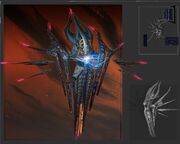
An Intrepid-class ship in 3189.
Detachment was a construction method where components lacked a physical connection with one another but remained a unit. It was a form of advanced technology. (DSC episode: "Die Trying")
History and specifications[]
In the year 2377, the Borg Collective manufactured a variety of starships and space stations that consisted of moving components, like the Borg wedge and the Borg harmonic defender. (ST video game: Armada II)
In 2384, Starfleet encountered a time travel artifact from 21 million years in the future that exploited the Casimir effect. It consisted of sequentially smaller and smaller scales that held together because the tiniest part relied microgravity attract one another. (DTI eBook: The Collectors)

Iconian ship with detached components.
From 2409 onward, the Iconian Empire deployed Herald starships in the galaxy. Herald ships included detached components. (STO - Romulan Mystery mission: "Cutting the Cord")
When the Iconian War erupted in 2410, the Khitomer Alliance engaged several Herald-operated Iconian ship classes that consisted of detached components, including Baltim-class raiders and Iaidon-class dreadnoughts. (STO - The Iconian War mission: "Blood of Ancients")
When the war ended at the Second Battle of Earth, the alliance had captured several Iconian ships, learning their technological secrets. (STO - The Iconian War mission: "Midnight")
In the 2250s decade, the Sphere Builders used ships that consisted of an engineering hull wrapped around a physically separate, rotating sphere primary hull, like the Arehbes-class frigate and Edoulg-class cruiser. (STO - Agents of Yesterday mission: "Terminal Expanse")
The Federation acquired these too in time for the Battle of Procyon V in 2554. (STO - Future Proof mission: "Ragnarok")

By the 30th century, Starfleet maintained a combination of ship classes with and without detached components, like the refit of the centuries-old Intrepid-class long-range science vessel.
In the 3180s, the ship of the United Earth Defense Force employed detachment for smaller components suspended on either side of the primary hull. (DSC episode: "People of Earth")
The Starfleet classes remained in service following the Burn in 3069. When the time-displaced USS Discovery arrived at Federation Headquarters, its crew was astounded to witness starships with detached warp nacelles, completely foregoing the traditional physical nacelle pylons. (DSC episode: "Die Trying")
Discovery, a 2250s-era Crossfield-class science vessel, underwent a three-week refit that included detaching the nacelles from the ship's engineering hull, a fact commented on by Captain Saru. Soon after, the Discovery encountered the heavy cruiser Viridian, flagship of the Emerald Chain, which also favored sectioning the hull. Cleveland Booker's ship used an advanced form of hull separation, where the ship could split up momentarily into smaller sections and rearrange itself in another shape in a process called morph. (DSC episode: "Scavengers")
When going to warp, the Discovery attached its nacelles. During travel at impulse engine velocities, using the spore drive, or remaining stationary, the nacelles remained detached. (DSC episode: "That Hope Is You, Part 2")
